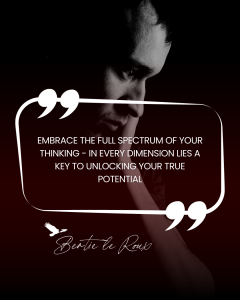In the world of cognitive psychology and self-discovery, the concept of left-brain and right-brain thinking has long been a point of intrigue. Often, we’ve been told that some people are more logical and analytical (left-brain dominant), while others are more creative and intuitive (right-brain dominant). But is this dichotomy really all there is to our cognitive abilities? The transcript we’re about to delve into sheds light on a more nuanced approach to understanding how our brains work, and how we can harness this knowledge to our advantage.
The Birth of the Quadrants
 The journey into whole brain thinking begins with a critical realization: the left-brain/right-brain dichotomy doesn’t capture the full spectrum of cognitive diversity. Instead, it inspired thinkers to explore further. The transcript mentions the development of a framework that divides our thinking into four quadrants: L1, L2, R1, and R2. The ‘L’ stands for left, and the ‘R’ for right, which serves as a foundation for more in-depth analysis.
The journey into whole brain thinking begins with a critical realization: the left-brain/right-brain dichotomy doesn’t capture the full spectrum of cognitive diversity. Instead, it inspired thinkers to explore further. The transcript mentions the development of a framework that divides our thinking into four quadrants: L1, L2, R1, and R2. The ‘L’ stands for left, and the ‘R’ for right, which serves as a foundation for more in-depth analysis.
Dissolving the Binary
This is where the concept takes an exciting twist. While it’s easy to categorize ourselves or others as either left-brained or right-brained, the creators of this framework recognized the complexity of human thought. Two individuals may both fall under the ‘left-brain’ category, yet their thinking preferences could be remarkably distinct. In other words, we are not limited to a binary classification.
The Emergence of Eight Dimensions
To account for this intricacy, the transcript highlights the development of the concept of eight Dimensions. Within each of the four quadrants, there exists a rich tapestry of cognitive diversity. Consider the example of the ‘realist’ and ‘analyst’ in the L1 quadrant. While they both reside in the same quadrant, their approach to thinking slightly differs, giving rise to unique cognitive profiles.
Personal Insight and Self-Discovery
Understanding this eight-dimensional framework can provide individuals with profound insights into their own thinking preferences. By answering specific questionnaires, individuals can pinpoint their cognitive profile with greater accuracy. This knowledge can reveal the percentage of alignment with various quadrants, shedding light on whether they lean more towards being an analyst or a realist, and much more.
Conclusion
The journey from a simple left-brain/right-brain divide to a multi-dimensional model of cognitive thinking is a fascinating evolution in the field of psychology. It demonstrates the richness and complexity of human thought. Embracing the concept of eight Dimensions allows us to explore the nuances of our cognitive preferences, offering a more accurate and holistic understanding of ourselves. This insight can be a powerful tool for personal and professional development, enabling us to leverage our thinking strengths and work effectively with others who may think differently. In the end, understanding the intricacies of whole brain thinking opens up a world of possibilities for personal growth and collaboration.
